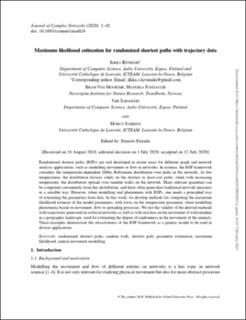| dc.description.abstract | Randomized shortest paths (RSPs) are tool developed in recent years for different graph and network analysis applications, such as modelling movement or flow in networks. In essence, the RSP framework considers the temperature-dependent Gibbs–Boltzmann distribution over paths in the network. At low temperatures, the distribution focuses solely on the shortest or least-cost paths, while with increasing temperature, the distribution spreads over random walks on the network. Many relevant quantities can be computed conveniently from this distribution, and these often generalize traditional network measures in a sensible way. However, when modelling real phenomena with RSPs, one needs a principled way of estimating the parameters from data. In this work, we develop methods for computing the maximum likelihood estimate of the model parameters, with focus on the temperature parameter, when modelling phenomena based on movement, flow or spreading processes. We test the validity of the derived methods with trajectories generated on artificial networks as well as with real data on the movement of wild reindeer in a geographic landscape, used for estimating the degree of randomness in the movement of the animals. These examples demonstrate the attractiveness of the RSP framework as a generic model to be used in diverse applications. randomized shortest paths; random walk; shortest path; parameter estimation; maximum likelihood; animal movement modelling | en_US |

